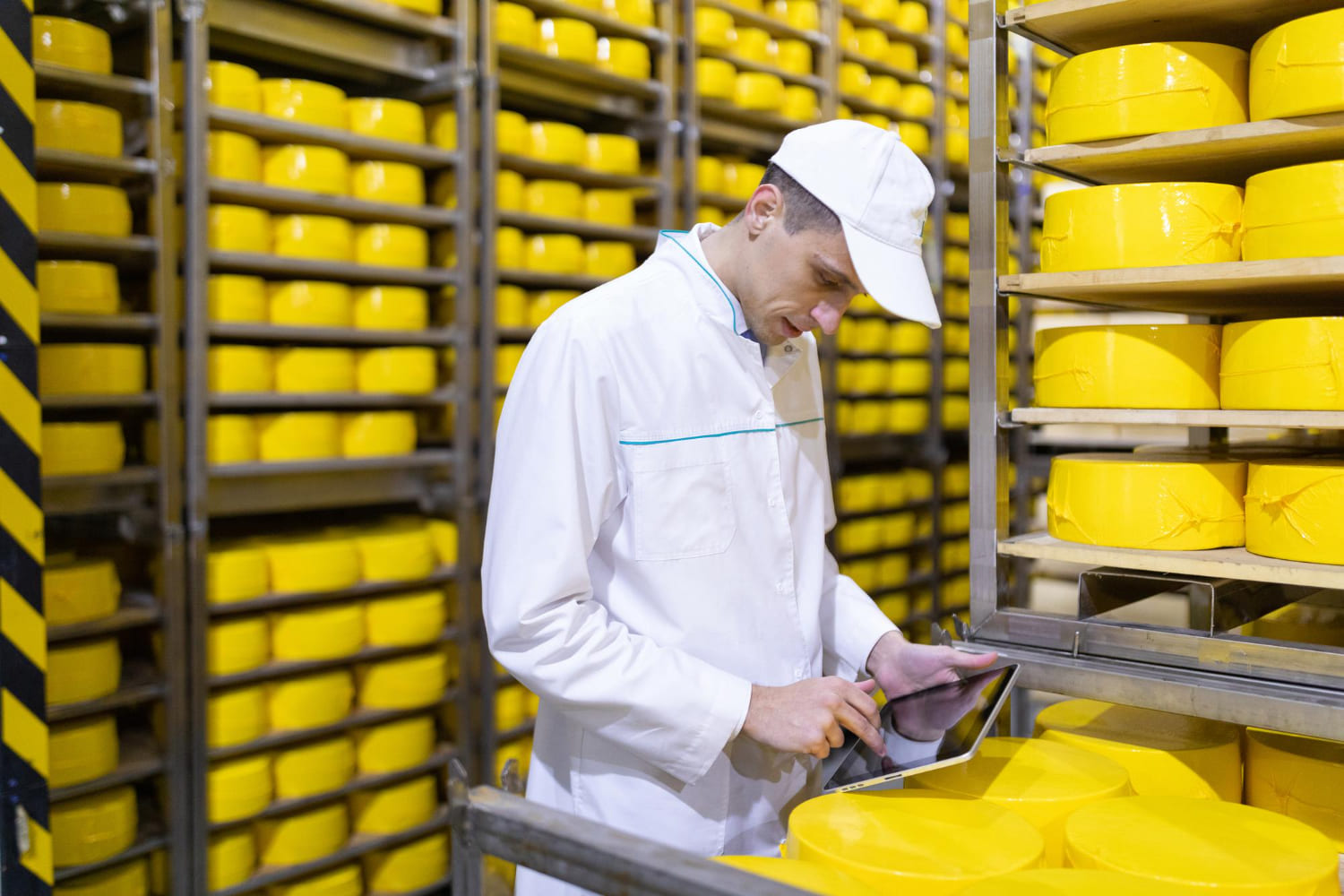HACCP Stands for Hazard Analysis and Critical Control Point. HACCP is an internationally recognized system for reducing the risk of safety hazards in food. HACCP is a rigorous food safety management system that aims to minimize or eliminate potential hazards by identifying and controlling them at critical points in the food production process. It is an essential tool for ensuring food safety and quality and is widely used by companies worldwide.
A HACCP System requires identifying and controlling potential hazards at specific points in the process. This includes biological, chemical, or physical hazards. Any company involved in the manufacturing, processing, or handling food products can use HACCP to minimize or eliminate food safety hazards in their product.
7 Principles of HACCP
HACCP Plans are prepared for each process or product and identify possible hazards and controls in place to make sure the hazards are eliminated or controlled to ensure acceptable levels in the food product.
There are 7 principles of HACCP:
-
Conduct a Hazard Analysis
This is where you evaluate your processes and identify where hazards can be introduced. Hazards can be physical (i.e. metal contamination), chemical (i.e. can a cleaning product contaminate the product, are there toxins that could contaminate the product?), or biological (at what points could bacteria or virus contaminate your product?). You will need to make sure that you have the expertise to make an accurate evaluation of the hazards. This means that if you do not have sufficient expertise in your organization you will need to identify external resources that you can use to perform the hazard analysis.
Hazard identification is done in two steps, first the identification of hazards, then an evaluation of the hazard. The hazard evaluation is a determination of the degree of risk to the user from the identified hazard. Once the hazard is identified and evaluated the team must identify critical control points. These are points where the hazard must be controlled or it will present a risk to the end user. -
Identify the Critical Control Points
At what steps in your process can controls be applied to prevent or eliminate the hazards that have been identified? These are your critical control points. For each critical control point, you will identify the preventive measure. How will you prevent the hazard?: Use of specific Temperature, ph, time, procedures?
-
Establish Critical Limits
Your next step is to establish criteria for each critical control point. What criteria must be met to control the hazard at that point? Is it a minimum temperature? Are there regulatory limits that you must meet for this control point?
Establish a maximum or minimum limit for temperature, time, pH, salt level, chlorine level, or other processing characteristics that will control the hazard. This is the critical limit for the CCP. If this limit is ever exceeded corrective action must be taken, and all affected product controlled. -
Establish Monitoring Procedures
What will you measure and how will you measure it? You need to monitor the process at the critical control point and keep records to show that the critical limits have been met. Can you do continuous monitoring of the control point? If not, how often will the measurements need to be performed to show that the process is under control?
The monitoring that takes place at the critical control points is essential to the effectiveness of the HACCP program. The monitoring program will be made up of physical measurements or observations that can be done in a timely manner, to provide the information in a time frame that allows you to take action and control product if an out-of-control situation occurs. -
Establish Corrective Actions
You will establish what actions need to be taken if a critical limit is not met. This will be identified ahead of time for each CCP. The action must make sure that no unsafe product is released. There must also be an evaluation of the process to determine the cause of the problem and an elimination of the cause.
The action or actions taken have two purposes, to control any nonconforming product resulting from the loss of control, and to identify the cause, eliminate it and prevent the situation from reoccurring. By identifying the corrective action before an out-of-control situation occurs, you are prepared to take action quickly if and when it does occur. -
Establish Record Keeping Procedures
You will determine what records are needed to show that the critical limits have been met, and the system is in control. Address regulatory requirements and include records from the development of the system and the operation of the system.
-
Establish Verification Procedures
The HACCP plan must be validated. Once the plan is in place, make sure it is effective in preventing the hazards identified. Test the end product, and verify that the controls are working as planned. Perform ongoing verification of the system. Are measuring and monitoring equipment in control? What are corrective actions showing? Are records being maintained as required?
HACCP Certification: Getting Started
The core of your Food Safety Management system is your Hazard Analysis-Critical Control Points Plan.
This plan is developed by the food safety team or HACCP team and any necessary outside expertise. Once the preliminary information has been collected, the team will use the information to identify all potential hazards in the ingredients and product.
A food safety professional can obtain their HACCP Certification by completing a HACCP certification course. This course will teach the requirements of HACCP and how to write a HACCP Plan.
Certification can apply to both companies and individuals, but the focus and requirements for each may differ.
Companies
For companies, HACCP certification is a process by which a company can demonstrate that it has implemented and maintains a food safety management system that meets the standards set by the HACCP principles. This typically involves a thorough assessment of the company’s processes and procedures, identification of potential hazards, and the development of measures to prevent, eliminate or control those hazards. The certification is usually awarded by an independent third-party certification body and is valid for a set period of time, after which the company must undergo a recertification process. HACCP programs are also implemented in companies that are using a food safety certification scheme such as SQF, FSSC 22000, BRCGS etc.
Individuals
HACCP certification for individuals involves training in the principles and practices of HACCP, with the goal of understanding how to identify and control food safety hazards in a food production environment and writing food safety plans.
In both cases, HACCP certification is an important tool for ensuring the safety of the food supply and promoting consumer confidence in the food industry. However, the focus and requirements for certification may differ depending on whether it is for a company or an individual.
Implementing HACCP in your Company
We will review the steps that a company needs to take to implement its HACCP Program.
As you build your food management system, you will need to identify information that is needed to conduct an effective hazard analysis. You will also need to collect, maintain, update, and document this information.
The first step to address these requirements is to establish your food safety team or HACCP Team. The members of the team will collect information on the characteristics of raw materials, ingredients, and end products and identify food safety requirements related to them and prepare descriptions to be used in the hazard analysis.
In addition to this information, the team will determine the intended use of the end products, considering the consumers of the product. It is up to the team to identify what potential risks there are of misuse or mishandling and if there is a particularly vulnerable group of people included in the consumers. The team documents the information to be used in the hazard analysis.
The next step is for the team to prepare flow diagrams for the products. The diagrams show the sequence and interaction of each step in the process for the product. It is important that this shows where raw materials, ingredients, and intermediate product enter the flow as well as where they are released or removed. All outsourced work is identified on the flowchart so it can be considered during the hazard analysis.
Once the diagrams are prepared the team verifies the diagram by on-site checking of the process against the diagram. The last piece of information to prepare to enable the hazard analysis is a description of the process steps and existing control measures. A description of any regulatory or customer requirements is included so they are addressed in the HACCP plan.
HACCP Training: Course List and Pricing
Registrar Corp offers convenient 100% online, self-paced HACCP training for all levels and in multiple languages.
Frequently Asked Questions About HACCP
What is the difference between HACCP and ISO 22000 / FSSC 22000 / SQF / GFSI…
HACCP (Hazard Analysis and Critical Control Points) and food safety certification schemes such as SQF, FSSC 22000 and others are both food safety management systems used by companies in the food industry to ensure the safety and quality of their products.
HACCP is a science-based system that identifies and controls food safety hazards. It involves a systematic approach to identifying and analyzing potential hazards, implementing measures to prevent or control those hazards, and monitoring and verifying the effectiveness of those measures. HACCP is often used as a basis for other food safety management systems, including SQF.
SQF, FSSC 22000, BRCGS, and ISO 22000, on the other hand, are food safety management systems that encompass HACCP principles but also include additional requirements related to quality and regulatory compliance. These systems involve a comprehensive evaluation of a company’s food safety and quality management systems, including documentation, policies and procedures, and facility management practices.
What is the difference between HACCP and a Food Safety Plan (preventive controls) / FSMA / PCQI
HACCP (Hazard Analysis and Critical Control Points) and HARPC (Hazard Analysis and Risk-Based Preventive Controls) are both food safety management systems that aim to prevent food safety hazards and ensure the safety of the food supply. While both systems use a risk-based approach, there are differences between the two.
HACCP is a preventive system that identifies and controls hazards at critical control points in the food production process. It is primarily used in the manufacturing and processing of food products.
The FSMA Food Safety Plan is a preventive system that focuses on identifying and controlling hazards throughout the entire food supply chain. FSMA requires companies to identify and control potential hazards throughout the entire production process, from raw materials to finished products. FSMA places greater emphasis on preventive controls that are designed to address potential hazards before they occur, rather than relying solely on monitoring and corrective actions.









